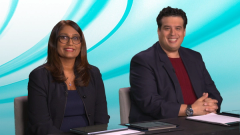
Treating High-Risk Transplant-Ineligible Newly Diagnosed Multiple Myeloma
Before closing out their module on transplant-ineligible newly diagnosed multiple myeloma, panelists reflect on best treatment practices in the setting of high-risk disease.
Episodes in this series

Transcript:
Sundar Jagannath, MD: Dr Rossi, you mentioned before that you would have done things slightly differently if the patient was high risk, but you didn’t talk more about it. How do you define high risk in older patients, and how would you tailor your therapy for high-risk patients?
Adriana Rossi, MD: There are 2 ways of thinking about it. Cytogenetics is a very helpful tool, but it doesn’t give us the whole story. My most useful data point is the response to therapy. She was substandardly treated, did not receive all the planned therapy, and still managed to get a very good response. That’s why I thought she was appropriate for single-agent maintenance. But in high-risk [disease], whether it’s defined by cytogenetics, lack of response, or early relapse, those are patients for whom I’d probably continue lower doses—maybe with a less intensive schedule, but a combination. If it were DRd [daratumumab, lenalidomide, dexamethasone], it would be continuing the daratumumab and the lenalidomide. If it were VRd [bortezomib, lenalidomide, dexamethasone], [it would be] continuing on a lower dose of the bortezomib as well.
Sundar Jagannath, MD: Is your choice of therapy in a high-risk patient—say, a 75-year-old—different? What would you choose? I have an 85-year-old with the same high-risk general dyslexic full 14 translocation with the deletion 13 and gain of 1q, which is considered fairly high-risk no matter which group gets that. How would you manage that patient who is 75 [years old]? And a patient who is 85?
Adriana Rossi, MD: I’d try to look beyond the age. We just had an 82- year-old who I’m taking to CAR [chimeric antigen receptor] T-cell therapy and another who is 72 years old, who I didn’t feel would tolerate the therapy as well. Looking beyond age, it’s fitness. If a patient were more frail, I’d lean toward a triplet [therapy] and the more robust [dose], regardless of age. If I think they can tolerate the first cycle of a quadruplet [therapy], then I’d probably start the quad and peel back as needed.
Sundar Jagannath, MD: How long would you continue treatment for them on that quad regimen?
Adriana Rossi, MD: [I’d continue until] best response or tolerability. Most patients don’t get beyond 4 cycles before I’m comfortable peeling away, either a drug or the frequency of therapy.
Sundar Jagannath, MD: You wouldn’t follow the quad to the 1-year mark or until deep response? You get 1 chance with older patients, so I’m trying to understand.
Adriana Rossi, MD: It’s the toxicity in older patients—the quality of life.
Sundar Jagannath, MD: If the patient didn’t have much toxicity?
Adriana Rossi, MD: Without toxicity you can keep going, right? To the best response or intolerable toxicity, but most of my older patients hit a barrier with quality of life. It’s easier to give in to with younger, fitter patients, who tend to tolerate it for a longer period.
Sundar Jagannath, MD: Josh, you have daratumumab, which also helps as an immunotherapy to overcome some of the high risks. As you mentioned, that proteasome inhibitor is good for high-risk patients. Typically for full 14, proteasome inhibitors are effective. In the same 85-year-old, intermediate [risk] and not very frail, because they’re over 80 [years old, that] automatically lowers them into the intermediate category, but the patient is otherwise OK. In an 85-year-old, what would the choice be? Would you choose 4 drugs? Would you choose 3 drugs? If it’s 3 drugs, will it be Velcade [bortezomib]? Will it be daratumumab? Give us a feel for how you approach the patient.
Joshua Richter, MD: One big difference between the design of SWOG-S0777 and MAIA trials is that in S0777, the triplet [therapy] was stopped and they went onto lenalidomide. In MAIA, it was the triplet [therapy] continually. As you alluded to, giving more robust therapy for longer improves outcomes. I temper this with some great work published by [Alessandra] Larocca and colleagues that was a takeoff of the first trial. As opposed to giving Rd [lenalidomide, dexamethasone] continuously, she gave Rd-R [lenalidomide-dexamethasone followed by lenalidomide maintenance], gave 9 months of Rd [lenalidomide, dexamethasone] full dose, and then dropped the dexamethasone and went onto lenalidomide. We saw this even before that, when we used to give R-D [lenalidomide, daratumumab], in the days of 4 days on, 4 days off. There’s a way of incorporating that. I like to give DRd [daratumumab, lenalidomide, dexamethasone] and perhaps after 9 months continue that but bring the lenalidomide dose down.
Sundar Jagannath, MD: Are there any other things about managing older patients? Dr Rossi?
Adriana Rossi, MD: No. With all our patients, [we want to] keep them part of the conversation and dynamic. Younger patients are more driven. You have that planned transplant. I very much agree with you about treating to best response or to a fixed number of cycles. You have the step in which we’re going to a transplant and to consolidation. With older [patients], it tends to not be as well defined. [You are] starting a combination and have this idea of continuous therapy. What are you going to continue and for how long? As long as they can tolerate it, [we treat until] best response in continuous therapy.
Sundar Jagannath, MD: Very good. Thank you.
Transcript edited for clarity.
Newsletter
Stay up to date on recent advances in the multidisciplinary approach to cancer.










